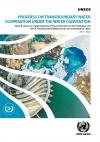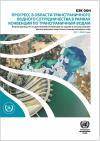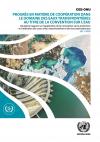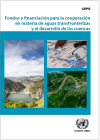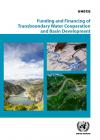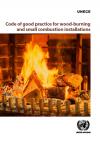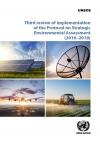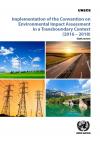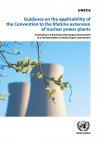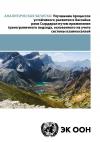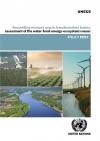Publications
Displaying Results 41 - 56 of 56
- English
The Convention on the Protection and Use of Transboundary Watercourses and International Lakes (Water Convention), hosted by the United Nations Economic Commission for Europe (ECE), requires Parties to prevent, control and reduce transboundary impact, use transboundary waters in a reasonable and equitable way and cooperate to ensure their sustainable management. Parties bordering the same
- Pусский
The Convention on the Protection and Use of Transboundary Watercourses and International Lakes (Water Convention), hosted by the United Nations Economic Commission for Europe (ECE), requires Parties to prevent, control and reduce transboundary impact, use transboundary waters in a reasonable and equitable way and cooperate to ensure their sustainable management. Parties bordering the same
- Français
La Convention sur la protection et l’utilisation des cours d’eau transfrontières et des lacs internationaux (Convention sur l’eau), dont le secrétariat est assuré par la Commission économique des Nations Unies pour l’Europe (CEE-ONU), exige des Parties qu’elles préviennent, maîtrisent et réduisent l’impact transfrontière, qu’elles utilisent les eaux transfrontières de manière raisonnable et
- Español
More than 60 per cent of the world’s freshwater flow is shared between two or more riparian states. The sustainable and cooperative management of these transboundary water resources is crucial for access to water, sustainable development as well as regional stability and peace. However, many countries and basins struggle to identify and mobilize the needed funding for transboundary water
- English
More than 60 per cent of the world’s freshwater flow is shared between two or more riparian states. The sustainable and cooperative management of these transboundary water resources is crucial for access to water, sustainable development as well as regional stability and peace. However, many countries and basins struggle to identify and mobilize the needed funding for transboundary water
- English
Domestic wood heating is a major source of emissions of particulate matter, including black carbon (BC), and organic pollutants, such as dioxins/furans, polycyclic aromatic hydrocarbons (PAHs) and benzo[a]pyrene (B(a)P), in the ECE region, resulting in poor local air quality conditions and significant negative effects on human health. The present document responds to the need to inform the
- Français
La majorité des ressources mondiales en eau sont partagées entre les pays. Ces eaux transfrontières créent des interdépendances sociales, économiques, environnementales et politiques qui font de la coopération une condition préalable au développement durable et à la consolidation de la paix. L’indicateur 6.5.2 des ODD mesure la coopération relative aux bassins hydrographiques et aux aquifères
- Español
La mayoría de los recursos hídricos del mundo son compartidos entre varios países. Las aguas transfronterizas generan interdependencias políticas, sociales, económicas y ambientales que hacen de la cooperación en materia de aguas transfronterizas una condición previa para el desarrollo sostenible y la paz. Mediante el indicador 6.5.2 de los ODS se mide la cooperación transfronteriza tanto en las
- English
Most of the world’s water resources are shared between countries. These transboundary waters create social, economic, environmental and political interdependencies that make cooperation a precondition to sustainable development and peace. SDG indicator 6.5.2 measures cooperation on both transboundary river and lake basins, and transboundary aquifers. In this second report on SDG indicator 6.5.2,
- العربية
Most of the world’s water resources are shared between countries. These transboundary waters create social, economic, environmental and political interdependencies that make cooperation a precondition to sustainable development and peace. SDG indicator 6.5.2 measures cooperation on both transboundary river and lake basins, and transboundary aquifers. In this second report on SDG indicator 6.5.2,
- Pусский
Most of the world’s water resources are shared between countries. These transboundary waters create social, economic, environmental and political interdependencies that make cooperation a precondition to sustainable development and peace. SDG indicator 6.5.2 measures cooperation on both transboundary river and lake basins, and transboundary aquifers. In this second report on SDG indicator 6.5.2,
- English
- English
- English
The Guidance on the Applicability of the Convention to the Lifetime Extension of Nuclear Power Plants was prepared by an ad hoc working group co-chaired by Germany and the United Kingdom of Great Britain and Northern Ireland, as mandated by the Meeting of the Parties to the Convention on Environmental Impact Assessment in a Transboundary Context (ECE/MP.EIA/27/Add.1–ECE/MP.EIA/SEA/11/Add.1,
- Pусский
This policy brief synthesizes the main findings and recommendations from the assessment of the water-food-energy-ecosystems nexus in the Syr Darya River Basin, shared by Kazakhstan, Kyrgyzstan, Tajikistan and Uzbekistan. The methodology employed was developed specifically for assessing the nexus in transboundary basins with multi-disciplinary expertise.
The assessment aimed to foster
- English
This policy brief provides an introduction towards the different stages of and benefits from an assessment of the water-food-energy-ecosystems nexus, with a specific focus on resource use in transboundary basins. It summarizes the experience from the first three transboundary basins where a methodology for participatory assessment of intersectoral linkages, trade-offs and benefits in


